Source of leather
The raw material primarily used in creating it is cattle hide. However, the most preferred and picked for the job is the cow hide. The cow hide is preserved to prevent decomposition by either salting or brining. In the occurrence of decomposition, the hide will be rendered unsuitable for use.
Moreover, the cow hide is thickest in comparison to other cattle hides. This particular trait plays a bigger role in the leather processing phase. It is split into two layers with the top one giving high quality leather in contrast to the bottom one.
The quality of leather is also determined by the state of the hide and feeds the animal gets. An animal with lots of pest bites will certainly provide a poor hide resulting to low quality leather.
Leather making process
As mentioned above, the preservation measure for the hides is salting. Once it is availed for processing, the hide is to be soaked in water for it to regain the lost moisture. To remove its hairs, the hide undergoes what is known as a lime bath. In this stage, the hide is soaked in calcium oxide. Furthermore, any residing flesh on the hide will be omitted by certain equipment consisting of blades.
After the soaking process, the hide will be about 4 mm thick. It is split into two with each meeting several purposes in the future. The bottom layer also referred as split leather can be split further as shown below. The leather is neutralized by ammonium sulphate after the lime soaking.
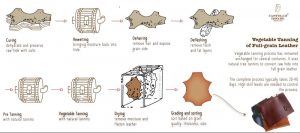
The next important stage of the leather making process is called Tanning. This process aids in the conversion of raw hides into leather. The hide is kept in a tanning drum with a tanning solution added. After the process, the leather is sorted and graded. Moreover, a second tanning process can be initiated to make certain that the leather is ready for use.
Lastly, the leather goes through its finishing phase. The leather is first dried upon completion of the tanning process. It is later on dyed to various colors and oiled to make it softer and water resistant.
Types of leather
There are several types of leather ranging solemnly on appearance, durability and quality. They are as follows below:
Full grain leather

This type of leather is obtained from the top layer of the cow hide. It is very costly than the other types and less workable because of its toughness. More so, full grain leather is the highest quality type and contains all the grains on the hide without the surface being tampered with either by buffing or sanding. This is the main reason why it is referred as ‘full grain.’
Full grain leather possesses a natural look bound by its imperfections and marks. This type of leather is breathable too. Once full grain begins to age, it transforms into a certain patina which gives it a beautifying and remarkable look. Full grain leather can be classified into two:
- Aniline leather
This type of leather is made from aniline dyes which are permitted to entirely soak through the hide. This technique might lead to variations of color on the hide. Aniline leather can be stained on and also fade with time.
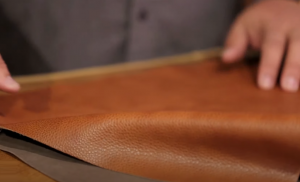
2. Semi-Aniline leather.
The process for making this type of leather is similar to aniline leather. The aniline dyes are permitted to entirely soak through the hide too. The main difference between the two comes from an added step on it.
After the initial similar process, a pigment color is included on the top surface to give it a consistent look. There is an addition of a protective layer to make the leather stain resistant and less exposed to the sun.
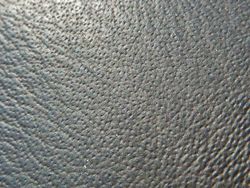
Top grain leather
Just like full grain leather, this type of leather is obtained from the top layer. It is the second best quality of leather and is easily workable. Top grain leather is sanded to remove the imperfections and marks on its top surface. This results in the omission of the natural grain and its strongest fibers.
The leather then gets an imitation grain which gives it a more appealing look and softer feel. Top grain leather is less breathable than full grain leather and is stain resistant.
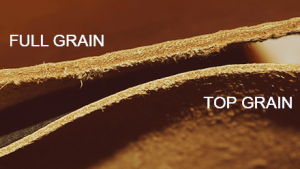
Nubuck leather
This type of leather resembles suede. Despite this, Nubuck leather is obtained from the top layer of the hide. When sanded, the hide gets a velvet-like appearance and touch. This type of leather can be dyed to any sort of color and is more durable than suede. A good factor is its aging can subsequently form a patina.
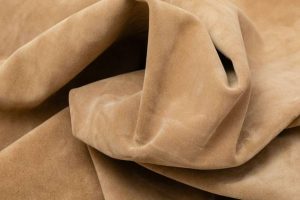
Split leather
As stated earlier, the hide is split into two. The bottom layer is referred as split leather. This type of leather is commonly used to provide suede used in the fashion industry to make jackets and shoes most specifically boots.
More so, split leather can undergo sanding and embossing for it to have a natural appearance. This can be a polyurethane layer or a vinyl layer on its surface thus resulting to the creation of another type of leather known as Bi-cast leather.
Bi-cast leather resembles the top grain leather but is cheaper in price. Bi-cast leather has a consistent texture and is also referred as genuine leather. However, unlike its name, Bi-cast leather isn’t durable and strong like the top layered leather. It tends to peel after a given time making it unsuitable for everyday use.
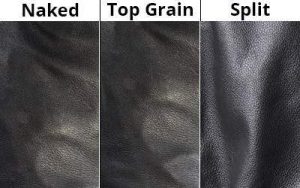
Bonded leather
Bonded leather can also be termed as reconstituted leather. Bonded leather consists of scraps of leather blended with polyurethane or other adhesives. The result of this action makes the material look like real leather yet the content it bears for leather alone is very minimal.
A potential buyer gets the feel of having a furniture or piece made of ‘leather’ but for a lower cost. One of easiest ways to tell whether it is bonded leather from real leather is by asking the price of the item. If the price is very affordable with a natural leather appearance, think twice.
Bonded leather is what is commonly used on bibles, photo albums and belts at times.
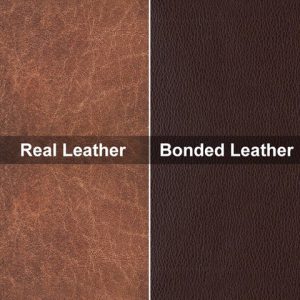
Faux leather
Faux leather is man-made leather made from Polyurethane and Vinyl. This type of leather is not comprised of any hides like the real leather. Vinyl is less breathable and softer compared to Polyurethane which can resemble real leather by look and feel. This man-made type of leather is durable and very affordable.
Faux leather can give multiple colors and texture types. Even though this type of leather can’t peel off or crack, it can tear unlike real leather. Finally, faux leather is incapable of forming a patina which is noted in real leather when it begins to age.
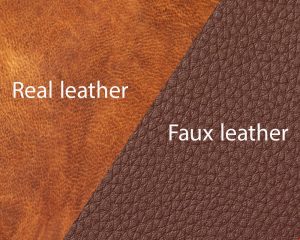
Tips on buying leather
When purchasing a furniture or material composed of leather, here are factors which you should have in mind:
- Durability- when searching for a type of leather which is durable and of high quality, opt for the top grain or the full grain leather. Nubuck leather is another pick you can select but stains can be a discouraging factor. It will require some maintenance.
- Price- this will vary depending on the grade of the leather a commodity contains. A grade of high quality will cost you more but will be worth it. A grade of low quality will give you the natural look of real leather at a low cost. This will come with its drawbacks too such as the leather peeling off or cracking with time.
- Suede vs. Nubuck- Though it’s not easy to tell them apart, these two are very different materials. Nubuck are obtained from the top part of the hide while suede is obtained from the bottom part. Nubuck have naps which are protein fibers on its surface. They are what give the leather a velvet appearance. Nubuck is stronger and rougher than Suede too. On the other hand, Suede is more porous than Nubuck. It requires a waterproof substance to prevent liquids such as water sipping through it.
- The grade of the leather– Before buying leather, know what you’re after and have alternatives too. This will be less time consuming if you were to find that the grade you wished to purchase was out of stock. Furthermore, if you are after real leather, avoid bonded leather or split leather. Any leather material which possesses polyurethane and vinyl to it is no true leather.
- Semi-aniline leather and aniline leather vs. pigmented leather– Pigmented leather color application is non-similar to the aniline leather coloring technique. Pigmented leather coloring is done by simple application on its surface. They are tougher than aniline leather in their feel but are stain proof and unaffected by scratching.
- Sauvage- it is a special effect on leather which gives it a creasing look.
- Terms used– Another term used for full grain leather is enhanced leather. Another term used for top grain leather is corrected leather. Moreover, ‘genuine leather’ as used in the stores is not entirely pure leather. It may contain a small percentage of leather with a combination of vinyl or polyurethane. This could be either bonded leather or Bi-cast leather.
How to identify real leather from faux leather
- Texture- Real leather can either be smooth or rough depending on the type. However, real leather is inconsistent in its feel as it is natural. On the other hand, faux leather has an exaggerated feel to it and is perfectly done.
- Pores- Real leather has variance in patterns along with inconsistency. Faux leather possesses patterns that are well done thus lacking the natural look.
- Constituents- Before purchasing the material, take a look at the label. If the constituents show the material is real leather, you can purchase it. Manufacturers will have nothing to hide if their material is real leather.
- Smell- real leather has distinct natural smell compared to faux leather. Faux leather bears a plastic-like smell.
- Factor of price- although highly priced furniture with real leather or leather itself should be a big indicator, this is not always a guarantee. Even faux leather can be highly priced to deceive the purchaser.
- Aniline leather and pigment leather- Aniline leather has a soft feel and is warm. Pigment leather has a coat which keeps it stain proof. It feels cold when touched. Semi-aniline leather is the result of these two types of leather.
Leather maintenance
- Leather should have minimum exposure to the sun.
- Keep leather far from abrasives to prevent scuffing.
- Use leather cream to add moisture to it.
- Store it in a cool and dry area.
- Opt for a damp cloth when cleaning it and avoid soaps.




